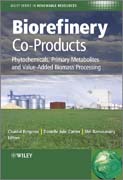
Biorefinery co-products: phytochemicals, primary metabolites and value-added
Bergeron, Chantal
Carrier, Danielle Julie
Ramaswamy, Shri
Part of the Wiley Series in Renewable Resources, this book is a comprehensivereference source devoted to the recovery of valuable phytochemicals from biomass. Following introductory chapters which discuss the concepts of phytochemicals and of biorefineries, the reader is presented with specific examples of phytochemicals that can be extracted from biorefinery-destined feedstock. The book concludes with chapters which discuss the uses of phytochemicals in the developing natural product industry, and phytochemical extraction from sustainability and compound separation perspectives. Topics covered include: Extractionof shikimic acid, and its use as a chemical precursor Extraction of medicinalcompounds from biomass Phytochemicals from sorghum, wheat and corn Phytochemicals from miscanthus and switchgrass Phytochemicals from algae Valuable compounds from citrus waste Phytochemical extraction and their uses in the developing natural product industry Extraction and separation techniques INDICE: Series Preface xiii Preface xv List of Contributors xvii 1 An Overview of Biorefinery Technology 1 1.1 Introduction 1 1.2 Feedstock 2 1.3 Thermochemical Conversion of Biomass 4 1.3.1 Fast Pyrolysis and Hydrothermal Liquefaction 4 1.3.2 Gasification 6 Catalysis Role in Gasification 7 Synthesis Gas Usage 9 1.4 Biochemical Conversion 10 1.4.1 Pretreatment 11 1.4.2 Enzymatic Hydrolysis 12 1.4.3 Fermentation 13 1.4.4 Pre-Pretreatment 14 1.5 Conclusion 15 2 Overview of the Chemistry of Primary and Secondary Plant Metabolites 19 2.1 Introduction 19 2.2 Primary Metabolites 20 2.2.1 Saccharides (Sugars) 20 Monosaccharides 20 Disaccharides 21 Oligosaccharides 21 Polysaccharides 21 2.2.2 Lignin 22 2.2.3 Amino Acids, Peptides, and Proteins 22 General Structure 22 Ecological Significance 22 2.2.4 Fatty Acids, Lipids 23 Fatty Acids 23 Phospholipids23 2.2.5 Organic Acids 23 2.3 Secondary Metabolites 23 2.3.1 Simple Phenols and Phenolic Acids 24 General Structure 24 Distribution 24 2.3.2 Polyphenols 24Phenylpropanoids 24 Coumarins 26 Quinones 26 Stilbenoids 27 Flavonoids 27 Tannins 29 Xanthones 30 2.3.3 Terpenes 31 General Structure Basic Unit 31 Monoterpenes and Sesquiterpenes 31 Diterpenes 32 Triterpenes 33 Tetraterpenes (Carotenoids, Xanthophyll) 34 2.3.4 Alkaloids 34 General Structure 34 Distribution 352.4 Stability of Isolated Compounds 35 2.5 Conclusion 35 3 Separation and Purification of Phytochemicals as Co-Products in Biorefineries 37 3.1 Introduction 37 3.2 Conventional Separation Approaches 39 3.2.1 Steam Distillation 39 3.2.2 Conventional SolidLiquid Extraction 40 Extraction with Organic Solvents 41 Extraction with Water or Oil 41 3.2.3 Ultrasound-Assisted Extraction 42 3.2.4 Microwave-Assisted Extraction 43 3.2.5 Pressurized Subcritical Liquid Extraction 44 3.3 Supercritical Fluid Extraction 45 3.4 Separation and Purification ofPhytochemicals from Plant Extracts and Dilute Solution in Biorefineries 46 3.4.1 LiquidLiquid Extraction 46 3.4.2 Membrane Separation 48 3.4.3 Molecular Distillation 48 3.5 Summary 49 4 Phytochemicals from Corn: a Processing Perspective 55 4.1 Introduction: Corn Processes 55 4.1.1 Dry Milling 56 4.1.2 Wet Milling 57 4.1.3 Alternative Wet Milling Processes 57 4.1.4 Dry Grind 59 4.1.5 Alternative Dry Grind Processes 61 4.1.6 Nixtamalization 62 4.2 Phytochemicals Found in Corn 63 4.2.1 Introduction 63 4.2.2 Phytosterols 65 4.2.3 Carotenoids 67 4.2.4 Polyamine Conjugates 67 4.3 Corn Processing Effects on Phytochemical Recovery 71 4.3.1 Research with Corn Fiber Obtained fromWet Milling and Dry- Grind-Based Processes 72 4.3.2 Research on Phytochemicals and the Nixtamalization Process 82 4.4 Conclusions 86 5 Co-Products from Cereal and Oilseed Biorefinery Systems 93 5.1 Introduction 93 5.2 Cereals 95 5.2.1 Wheat 95 5.2.2 Barley 100 5.2.3 Sorghum 101 5.3 Oilseed Biorefineries 102 5.3.1 Oil- and Oilseed-Based Products 104 Edible Products 104 5.3.2 Industrial Products 106 5.4 Conclusions 108 6 Bioactive Soy Co-Products 117 6.1 I
- ISBN: 978-0-470-97357-8
- Editorial: John Wiley & Sons
- Encuadernacion: Tela
- Páginas: 328
- Fecha Publicación: 09/03/2012
- Nº Volúmenes: 1
- Idioma: Inglés
